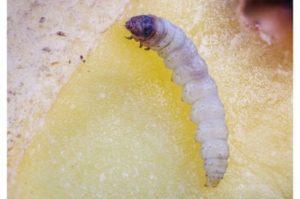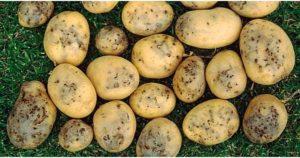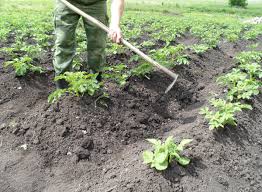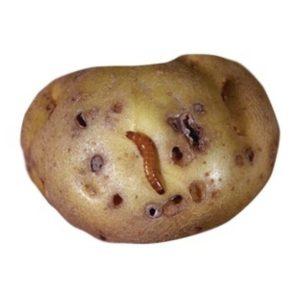How to Get Rid of Potato Moth: 3 Proven Methods
Content
Among the various species of moths, the potato moth is unremarkable. It looks inconspicuous, but it does harm to potato plantings and harvested crops no less than the Colorado potato beetle, which enjoys productivity. The pest must be recognized and destroyed much earlier than it will spoil the crop.
What does potato moth look like (photo)
General characteristics
Name: Potato moth
Latin: Phthorimaea operculella ZellClass: Insects - Insecta
Squad: Homoptera - homoptera
Family: Triosides - Gelechiidae
 | Habitats: | potato storage areas, vegetable garden |
 | Dangerous for: | potatoes, nightshade crops |
 | Means of destruction: | bioinsecticides, pyrethroids |
insect size
Butterfly moths are small in size, up to 8 mm long, and with a wingspan of up to 13 mm. The adult has antennae and mouthparts, but it does not function as intended. The larvae are small, inconspicuous, reaching 6-8 mm in length.
Eggs and larvae of the pest
Potato moth eggs are very small, whitish, up to 0,8 mm long. They are located on the back of the leaves, near the cuttings or veins. If bare tubers peek out from under the ground, then it is on them that masonry can be found.
Small newborn larvae do not reach even 2 mm in size.. They are naked and pale. As they grow and feed, the bodies of the caterpillars become greenish if they feed on vegetative parts, or brownish if they feed on tubers. The size of adult caterpillars reaches 12 mm, the body is clearly segmented.
Life cycle
There are four periods that the potato moth goes through:
- The egg, which is already laid, turns into a larva in a week in summer, and about a month in winter.
- The larva molts four times during the maturation period, which lasts up to three weeks in summer and two months in winter. During this time, the insect causes maximum damage.
- When the larvae have eaten and prepared a cocoon, they enter the pupal stage. The period lasts in the warm season no more than 5 days, and in winter it can even last about 3 months.
- The butterfly grows very quickly, its lifespan is no more than a few days in summer and weeks in winter. During this time, she mates several times, and in one clutch she can lay up to 200 eggs.
From the appearance of a moth to the age when it can already mate, no more than a day passes. The laying process itself can take up to two weeks. During a warm summer, even 5 generations of a malicious pest may appear.
What feeds on
It is quite logical that the potato variety feeds on potatoes. When the tops are still green, caterpillars actively eat them. Closer to autumn, when the vegetative parts dry out, the caterpillars move to the tubers and get inside through the eyes.

Potato moth feeds on tubers and green shoots.
How and where does it winter
An insect can survive the cold only in the state of chrysalis, less often as a caterpillar. Departure most often begins in May.
In more comfortable conditions, for example, when potato tubers are stored in the cellar, they can not only be stored, but also multiply in winter.
Geographic distribution
Central and South America is considered the birthplace of the potato and at the same time the birthplace of the pest. More than 50 years have passed since its discovery in the Black Sea region. It is believed that insects were brought to Russia with tomatoes, tobacco and potatoes.
Features of development
There is one feature that does not please gardeners. Moth can develop under almost any conditions. But temperature plays an important role:
- at low rates from +15 and less, the life cycle is about 150-200 days;
- if the ambient temperature is about +20 degrees, then a cycle will pass in 70 days;
- at rates of about 30 degrees, the appearance of an insect from an egg and its transformation into an adult will last about a month.
In summer, under stably high temperature conditions, young voracious insects will appear every 14 days. That is why in the summer the crop is often very damaged.
How to get rid
There are several ways to get rid of potato moth, this voracious pest. Some of them are quite simple, while others require preparation.
Biological method
Biological products or, more precisely, bioinsecticides are the waste products of bacteria that have a toxic effect on pests. They act not so rapidly, up to 10 days, but are absolutely safe for people.
Biological preparations are often used before storing tubers. You need to be careful, because their validity is usually a year, only some two.
The most common are: Entobacterin, Lepidocide, Bitoxibacillin Dendrobacillin.
Chemical method
Against fluorimea, as the potato moth is scientifically called, chemicals are nothing more than pesticides. They are used for spraying. They are toxic and cannot be used later than 21 days before harvest.
- Ambush;
- Arrivo;
- Intavir;
- You decide.
- Foxim;
- Fozalon;
- Volaton.
Agrotechnical method
The agrotechnical method includes proper planting and cultivation to reduce the number of insects. Here are some measures to combat potato moth:
- Proper planting at the right depth so that insects do not get to the tubers.

Hilling potatoes.
Planting an early variety, still a small pest population.
- Hilling of bushes and cleaning of row-spacings.
- Sprinkler irrigation to remove caterpillars.
- Timely harvesting and sorting.
If you properly care for and clean the site, then the risk of insects is minimized.
Potato storage protection
Before laying the crop for storage, it must be sorted out. Remove all damaged tubers so that pests do not get on healthy vegetables from them. The room also needs to be cleaned by fumigation or washing with a solution of iron sulfate and lime.
You can process the tubers themselves. For this, biosolutions are prepared, in which tubers are placed for several minutes. Then they need to be dried well and can be sent for storage.
Prevention
To protect plantings from the fluorimea pest, a number of preventive measures must be taken.
Among them:
- purchase of material for planting only in verified places;
- germinate tubers;
- remove weeds and hill up plantings;
- timely cleaning;
- process before disembarkation and before laying in storage.
Treatment with special preparations against Colorado potato beetles will also help against potato moths.
Conclusion
Potato moth can quickly destroy large potato plantations. And if not completely removed, then pretty spoil, make unsuitable for storage and further planting. It is better to carry out all possible preventive and treatment measures in order to prevent the spread. Armed with information about the characteristics, it becomes clearer how to deal with potato moths.
Previous



